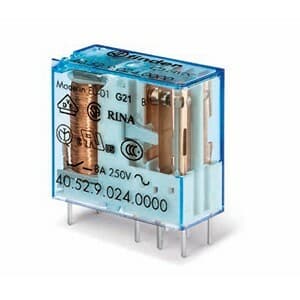Schneider Electric Control Circuits on Powermatic Associates


Control Circuits- Schneider Electric
A control circuit is an essential part of electrical systems that allows for the control and management of various electrical devices. It acts as a relay point between a power source and devices, receiving input from sensors and sending instructions to control the actions of connected devices.

296 products available

Schneider Electric XEND1611 is a contact block designed for front mounting withi...
Quick Quote

Schneider Electric 9001KYSK210 is an assembled corrosion-resistant control stati...
Quick Quote

Schneider Electric CA3KN22ED3 is a control relay designed with a mechanical dura...
Quick Quote

Schneider Electric CA3KN225BD3 is a contactor designed with a mechanical durabil...
Quick Quote

Schneider Electric CA2KN40R7 is a contactor with a mechanical durability of 10,0...
Quick Quote

Schneider Electric CA2KN40FE7 is a contactor with a mechanical durability of 10,...
Quick Quote

Schneider Electric CA2KN403B7 is a contactor with a mechanical durability of 10,...
Quick Quote

Schneider Electric CA2KN317B7 is a contactor with a mechanical durability of 10,...
Quick Quote

Schneider Electric CA2KN313B7 is a contactor with a mechanical durability of 10,...
Quick Quote

Schneider Electric CA2KN227M7 is a control relay with a mechanical durability of...
Quick Quote
| Item | Manufacturer | Price | Stock | Delivery | |
|---|---|---|---|---|---|
 | XEND1611 Schneider Electric XEND1611 is a contact block designed for front mounting withi... | Schneider Electric | Quick Quote | ||
 | 9001KYSK210 Schneider Electric 9001KYSK210 is an assembled corrosion-resistant control stati... | Schneider Electric | Quick Quote | ||
 | CA3KN22ED3 Schneider Electric CA3KN22ED3 is a control relay designed with a mechanical dura... | Schneider Electric | Quick Quote | ||
 | CA3KN225BD3 Schneider Electric CA3KN225BD3 is a contactor designed with a mechanical durabil... | Schneider Electric | Quick Quote | ||
 | CA2KN40R7 Schneider Electric CA2KN40R7 is a contactor with a mechanical durability of 10,0... | Schneider Electric | Quick Quote | ||
 | CA2KN40FE7 Schneider Electric CA2KN40FE7 is a contactor with a mechanical durability of 10,... | Schneider Electric | Quick Quote | ||
 | CA2KN403B7 Schneider Electric CA2KN403B7 is a contactor with a mechanical durability of 10,... | Schneider Electric | Quick Quote | ||
 | CA2KN317B7 Schneider Electric CA2KN317B7 is a contactor with a mechanical durability of 10,... | Schneider Electric | Quick Quote | ||
 | CA2KN313B7 Schneider Electric CA2KN313B7 is a contactor with a mechanical durability of 10,... | Schneider Electric | Quick Quote | ||
 | CA2KN227M7 Schneider Electric CA2KN227M7 is a control relay with a mechanical durability of... | Schneider Electric | Quick Quote | ||


